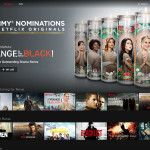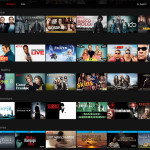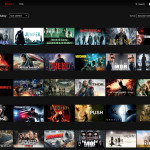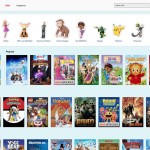
review Australians have spent years waiting for US Internet television giant Netflix to launch its popular streaming service in Australia. But now that the service has finally launched Down Under, is it worth paying cash money for on a monthly basis? Read on to find out.
How it works
If you’re not familiar with it, it’s easiest to think of Netflix as being very similar to Google’s YouTube platform. In its default form, it’s a webpage full of links to thousands of videos which you can click on and quickly start to watch. You get very similar controls to YouTube — you can pause, play, skip ahead in the video and change the volume.
But Netflix differs from YouTube in two essentials ways. Firstly, Netflix doesn’t stream user-generated content like YouTube does. Instead, it streams full seasons of TV shows — you can pick whatever episode to watch you like — as well as films. This is commercial content which has cost a great deal to make, and Netflix has to sign complex arrangements to licence it in each geography it makes it available to.
This leads us to the second essential difference: Cost. There are no ads, but you’ll need to sign up to access Netflix for a monthly fee. The company gives Australians a free month, and there are other ways to get access for free for a certain time — such as specific deals around buying a new Samsung TV or an Xbox One — but in general you’ll ned to pay at least $8.99 per month to get a login to Netflix.
$8.99 per month will allow you to login to Netflix on a single device at a time and watch shows in standard definition, but we recommend most people sign up at least for the $11.99 upgrade, which allows viewers to watch a high-definition stream on two devices simultaneously. If you have a television with 4K viewing capability or a very large family, you may want to check out the $14.99 option, which allows four streams of 4K quality simultaneously, but we suspect this will be overkill for almost everyone.
This is just the up-front cost, however. You’ll also need to consider the impact on your broadband data quota. Streaming Netflix to your house will soak up at least 300MB per hour at the lowest quality, while standard definition quality will use 700MB per hour, HD will use up to 3GB per hour, and ultra HD will use a whopping 7GB per hour.
If you’re with Optus, Skymesh with a National Broadband Network connection or one of the iiNet group of broadband providers (Internode, Westnet, Netspace, Adam Internet and TransACT/Grapevine), all content from Netflix Australia won’t count towards your quota, but if you’re with another ISP, you’ll need to consider the impact on your broadband plan’s bottom line — you may end up needing a higher quota plan if you watch Netflix a lot. It may even be worth switching to iiNet, Optus or Skymesh just for the Netflix free quota.
Your broadband connection will also need to be fast enough to watch Netflix. A connection of 5Mbps or higher is recommended for HD quality viewing, while you’ll need a connection of 500kbps to watch the service at bare minimum. A 25Mbps connection (which few on ADSL broadband will have) is recommended for the top-end Ultra HD quality.
This leads us to the question of how to watch the content.
Netflix integrates with virtually every modern computer, gaming and television platform. You can watch it via a web browser on any PC or laptop, but you’ll probably find it more useful to install its app on your TV directly (most modern smart TVs purchased over the past couple of years will support Netflix, as long as they have an Internet connextion) or on a device that’s already sitting in your loungeroom such as an Xbox, PlayStation or Nintendo console, or a dedicated TV device such as an Apple TV or Google Chromecast.
We’ve also found it extremely useful installing Netflix on our house smartphones and tablets (Netflix works on Apple’s iOS platform, Google’s Android platform and Microsoft’s mobile Windows platform), so that other members of our family can still watch Netflix if someone’s hogging the TV in the loungeroom. Just download the app on any of these platforms, log in with the email address you signed up with, and away you go.
On every platform we’ve tested it on — PC, Mac, PlayStation 3 and 4, iPhone and iPad — the Netflix app and streaming service was extremely quick and easy to use. The quality of the streaming was excellent and it was quick to skip ahead or back in whatever content you were watching. It was even easy to watch Netflix on a 3G or 4G connection on a mobile phone.
What you get
When you think about the content available on Netflix, don’t think of it as the sort of service where you’ll be watching the sorts of shows you normally find on free to air Australian television — Netflix is not great at providing access to sports or shows such as Home and Away, Masterchef, Australia’s Biggest Loser and so on. These shows remain specific to Australian free to air television or the websites of the individual TV networks.
Instead, Netflix is one of the best places to catch up on popular movies and hit TV shows, generally from the US, with a small spattering of international content. It has a huge roster of premium US TV shows and movies that are hard to watch conveniently otherwise.
For example, at the moment I’m working my way through shows such as Vikings, Lost, House M.D., Prison Break, House of Cards and Spartacus — a mix of old and new content that I’m catching up on. I’ve watched a few movies on Netflix and I’m about halfway through a nostalgia session of The Godfather 2 that I spend 15 minutes here and there on at the moment. A family member of mine is using the service to watch the show Orange is the New Black.
While the content is great, it’s important not to think of Netflix as the solution to all of your TV viewing habits. There is definitely quite a lot of premium TV content on the service, but you won’t find recent hit US shows such as Breaking Bad, Game of Thrones or Parks and Recreation on Netflix Australia.
The same is true with with movies — while you will find new release movies on the service, don’t count on any given film being available on Netflix, because while there will definitely be similar movies in its category, the specific film you’re after will probably not be available.
Part of this problem relates to the difference between the content available on Netflix in Australia and Netflix in the US. Licensing deals specific to each geography means that there are quite a few thousand less titles available in Australia compared with the US. Netflix won’t divulge the precise number, but some estimates have placed the number of titles available in Australia at around 1,300, while the US has about 8,500 and Canada 4,400.
Gizmodo has conducted analysis showing that 20 geeky TV shows chosen at random were available on the US version of Netflix, but not the Australian version, while Lifehacker has conducted a similar experiment relating to recent popular movies and found that again, significantly less titles are available in Australia compared with the US.
However, part of the problem is also bulk licensing in general — some major US networks, such as HBO, the producer of Game of Thrones — don’t offer their content on Netflix at all, no matter where you access Netflix from. Instead, they have exclusive deals with pay TV giants like Foxtel in Australia.
So what does this mean for the Australian consumer? In general, it means you probably won’t completely stop watching free to air TV because you have a Netflix subscription, and you’ll also need to find a way to access some new release films and premium TV shows like Game of Thrones, because there is just so much content that you won’t find on Netflix. What there is on Netflix is good — loads of popular films, loads of popular TV shows, and great kids content — and Netflix is regularly adding new content as it works out Australian licensing arrangements — but it’s not comprehensive by any means.
Note: There are ways to access the full range of US Netflix content through services such as Getflix, Unblock.us and UnoTelly, which connect your Australian device to Netflix through a virtual private network service. The legality of such devices is in a little bit of a grey area, but we haven’t seen anyone being penalised for using them. They typically cost between $4 and $5 per month, which adds a little to the cost of a Netflix subscription. However, as things currently stands, they appear to represent good value and significantly enhance the value of a Netflix subscription. If you’re spending a lot of time in Netflix, we recommend checking them out.
What it’s like to use the platform, and do we recommend it?
Much of the debate around services like Netflix relates to whether certain films or TV shows are available on the platform, and Netflix’s fitness for purpose tends to be judged on this basis.
However, in practice, what I’ve found with respect to practical use of Netflix is that using the service tends to change your personal TV viewing habits, and that it’s impractical to judge the service solely on the basis of what content it theoretically has available on it in terms of raw numbers or specific shows.
The reason for this is that having access to Netflix in reality is a bit like having access to free to air TV. You may load it up having an idea of some specific show that you want to watch. However, in practice if you can’t find that TV show or film, you’ll probably browse around and start watching something else on Netflix anyway, because there will be something else similar in the same category that will probably do.
The particular romantic comedy you wanted to watch may not be available on Netflix, for example, but there will be other romantic comedies on Netflix that you are interested in as well, so you may start watching one of those instead.
You may also find yourself watching older content that you didn’t catch when it was first aired years ago. For example, even though I am watching new release TV shows on Netflix such as House of Cards, I’m also re-watching House M.D. and Lost, which first started airing in 2004. I never watched these series the whole way through the first time around, so I’m doing that gradually now. This isn’t really stereotypical TV use — but a lot of it goes on on Netflix.
Another factor is that Netflix remembers where you’re up to — with every single piece of content that you’ve watched. So, for example, if you’re halfway through Season 3, Episode 4 of House, the next time you load up Netflix on any device — PlayStation, iPhone or TV, you can just jump straight back in to whatever show you want to. And the video and audio streaming quality — whether on TV or iPhone — is very good and very quick to load.
This changes viewing habits substantially. Previously, if I only had a few moments to relax, I might sit down with a book for ten minutes.
Now, in practice, I find this ‘bookmarking’ feature means that I am more likely to watch Netflix than any forms of content in my spare time — because after looking after the kids for a couple of hours, it’s just so easy, quick and convenient to fall back on your bed, hit a couple of buttons on your iPhone and watch a few more minutes of whatever show you’re watching on Netflix, without really thinking about it. The streaming platform is so quick and well-thought-out that you kind of default to it often.
It is also particularly useful for breastfeeding women who may not be sitting in front of the TV when they have a spare moment to catch up with their Netflix.
Netflix’s user interface is notoriously so well-thought-out that it becomes addictive at times. For example, the next episode of a TV show starts auto-playing just seconds after you finish an episode, meaning it’s sometimes a little too easy to just relax and keep watching.
All of this and the relatively trivial monthly subscription cost means that if your family spends anything more than an hour or so in total watching TV every day, then we suspect Netflix will very likely wind up easily finding a place as a cost-effective and useful addition to your household’s TV entertainment roster. It will most likely not be the only platform you use. But it will be a very useful and functional one that dramatically expands the amount of content you have available to you.
Netflix very quickly found its own permanent niche in our household. Try it out for a month for free — I recommend it.
Note: Over the next week or so Delimiter will also be reviewing the other Internet TV streaming options available in Australia — Stan, Quickflix and Foxtel’s Presto. We have already reviewed FetchTV but will also post an update on this service. At the end of this period we will be producing an overall article recommending the ‘Best Internet television service in Australia’ with our thoughts on the different platforms and which one you may like most, or how they can best be used together. Stay tuned for this coverage.
Image credit: Screenshots of Netflix









Might be a good idea to include that you can create user profiles for all your household members on your Netflix account. Along with that ‘bookmarking’ feature, it also generates suggestions by your viewing habits on each user profile.
At first we’d wondered whether it was worthwhile as it didn’t have many of the shows we would have liked. But as you suggested in the article, we’ve started watching things on the service just because it is there.
Ah yes, very good point — had that in the back of my mind, will add it in!
Yeah, this is how I’ve started to think about Netflix. It’s a bit like Steam or the iOS or Android app stores — if you have Steam installed on your gaming PC, you will probably buy the odd game on it just because it’s there in your face and looks interesting — same with mobile apps. I have found myself watching all kinds of weird things on Netflix just because it’s there and oh-so-convenient.
it needs a request system.. for adding new content
I use the search function as a request system. Hopefully if they notice a search frequently for the same content it might get them to source it for the Australian region. I could be dreaming though
+1
+1..
Also it would be good if they had a comment like “We are in discussions for this content would you like to be notified of updates?” or some such.
Err… This is back to front, “Licensing deals specific to each geography means that there are quite a few thousand more titles available in Australia compared with the US.”
Cheers, fixed!
I have both Netflix and Foxtel. If I want to get pissed off, and be bombarded with ads, I’ll watch Foxtel, otherwise its Netflix hands down. Netflix is less than 10% of the cost of Foxtel too. Foxtel is living on borrowed time in my household.
(Admit to a bit of skim reading but…) Didn’t see any mention of the impact of Netflix on the network performance of the major ISPs. IINet admitted to problems but apparently are in the process of fixing them or already have. Optus have not but their network is royally screwed, cable in particular, but also ADSL and even their NBN offerings are suffering in a lot of places. Telstra probably haven’t got too many issues. So if you are thinking of taking on a Netflix subscription make sure your ISP can service the bandwith and download performance.
I’m on Adsl2 with IInet, I have definitely noticed it (altho it is not as bad now). That said, Netflix still performs surprisingly well. Sometimes the “low quality initial feed” lasts a little longer, but its still hits SD quality quick enough that you don’t really notice it.
I have had one instance where the Audio was out of sync, this was recently. I have had one instance where the low quality lasted almost the entire episode (Daredevil) but this was early on when IInet where still suffering.
I have watched a lot of TV on it since getting. Way more than I normally do.
Interesting point. I haven’t noticed any performance issues myself, but then I’m on FTTN Transact at 65Mbps. I suspect the performance problems will be ironed out quickly though — nobody will want to get a reputation as the ISP which can’t handle Netflix.
I would say the quality of the Netflix streaming platform helps avoid a lot of problems as well — it’s as good as I’ve seen.
Something else to mention is that Netflix does seem to support local industries, if you look through the lists you will often find “Netflix Original” series that are local to various regions, but available to all on Netflix.
The best thing I have found with it, is that I am suddenly watching anime again.
I used to watch a lot of Anime in my teens/twenties, back in the 90s. But I really haven’t watched much in the last 10 years or so. Mostly because there was no easy way of telling the gold from the dross, and unlike my younger days I have to be a little more choosy on my time spend. But having all this on hand, has meant late at night whilst working, I have flicked on netflix and have now knocked off 3 or 4 entire series of various anime, and that is on top of the various Sci Fi stuff I have been watching.
For anyone interested I highly recommend “Fairy Tale”. It has that great mix of humour, seriousness and insanity that always drew me to Japanese animation.
I had a look at the anime section but didn’t see much that I was keen on — I prefer the Crunchyroll online streaming service for anime. Doesn’t appear to have any geoblocks either, and a much wider selection.
Hmmm I will check it out… Netflix has reinvigorated my desire to watch anime, so I may now need a better service to get my fix ;-)
I have written a few posts about Netflix recently, and I think it is great, although I think that there are some issues with the UI (which seems a bit clunky) and also the lack of the same content (we in Australia get the least) – even missing out on Netflix Originals like Peaky Blinders.
The quality is great there is just not enough tv shows or movies why don’t we get the same as in the US.
Rally nice review, truly think that Netflix will take over traditional media consumption methods in the coming years. If Netflix was to branch into sport then that would make things very interesting. Came across this website which has full lists of streaming services and Netflix related content http://streamingservices.com.au/
Netflix has different streaming rights for different countries, and started blocking proxies/VPNs. I am using Hide My IP its DNS protection (has to be enabled) blocks Netflix from seeing user’s real IP. That’s the reason maybe HMIP is still working.
Comments are closed.